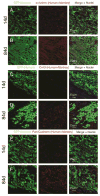Cardiac regeneration using pluripotent stem cells--progression to large animal models
- PMID: 25087896
- PMCID: PMC4253057
- DOI: 10.1016/j.scr.2014.06.005
Cardiac regeneration using pluripotent stem cells--progression to large animal models
Abstract
Pluripotent stem cells (PSCs) have indisputable cardiomyogenic potential and therefore have been intensively investigated as a potential cardiac regenerative therapy. Current directed differentiation protocols are able to produce high yields of cardiomyocytes from PSCs and studies in small animal models of cardiovascular disease have proven sustained engraftment and functional efficacy. Therefore, the time is ripe for cardiac regenerative therapies using PSC derivatives to be tested in large animal models that more closely resemble the hearts of humans. In this review, we discuss the results of our recent study using human embryonic stem cell derived cardiomyocytes (hESC-CM) in a non-human primate model of ischemic cardiac injury. Large scale remuscularization, electromechanical coupling and short-term arrhythmias demonstrated by our hESC-CM grafts are discussed in the context of other studies using adult stem cells for cardiac regeneration.
Copyright © 2014. Published by Elsevier B.V.
Figures




References
-
- Assmus B, Schachinger V, Teupe C, Britten M, Lehmann R, Dobert N, Zeiher AM. Transplantation of Progenitor Cells and Regeneration Enhancement in Acute Myocardial Infarction (TOPCARE-AMI) Circulation. 2002;106(24):3009–3017. - PubMed
-
- Balsam LB, Wagers AJ, Christensen JL, Kofidis T, Weissman IL, Robbins RC. Haematopoietic stem cells adopt mature haematopoietic fates in ischaemic myocardium. Nature. 2004;428(6983):668–673. - PubMed
-
- Bel A, Planat-Bernard V, Saito A, Bonnevie L, Bellamy V, Sabbah L, Menasche P. Composite cell sheets: a further step toward safe and effective myocardial regeneration by cardiac progenitors derived from embryonic stem cells. Circulation. 2010;122(11 Suppl):S118–123. doi: 10.1161/CIRCULATIONAHA.109.927293. - DOI - PubMed
-
- Beltrami AP, Barlucchi L, Torella D, Baker M, Limana F, Chimenti S, Anversa P. Adult cardiac stem cells are multipotent and support myocardial regeneration. Cell. 2003;114(6):763–776. - PubMed
Publication types
MeSH terms
Grants and funding
LinkOut - more resources
Full Text Sources
Other Literature Sources

